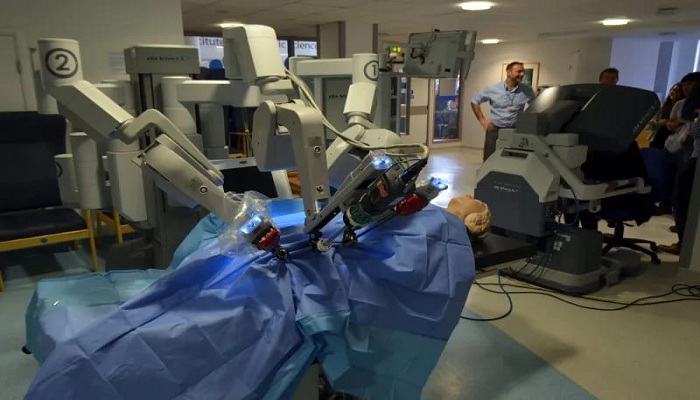MEDICAL ROBOTICS

MEDICAL ROBOTICS
Published On: 05-10-2024 | 4 min Read
Medical robotics represents the next wave of innovation in healthcare, promising to revolutionize every aspect of patient care. As robots continue to become more advanced, accessible, and integrated into the healthcare system, we can expect a new era of medicine characterized by precision, efficiency, and improved outcomes. While challenges remain, the potential benefits of medical robotics make it one of the most exciting areas of development in modern medicine. The future is robotic, and healthcare will never be the same.
MEDICAL ROBOTICS:THE FUTURE OF HEALTH CARE
In the rapidly advancing world of healthcare, one of the most exciting frontiers is the integration of medical robotics. With technology evolving at breakneck speed, robots are set to revolutionize healthcare in ways that were unimaginable just a few decades ago. From robotic-assisted surgeries to automated diagnostics, medical robotics represents a profound shift in how healthcare is delivered, promising greater precision, efficiency, and accessibility. We NSMS Nursing Institute explore how medical robotics is shaping the future of healthcare and what it means for patients, doctors, nurses and the industry as a whole.
1. Robotic-Assisted Surgeries: Precision and Minimally Invasive Procedures
One of the most well-known applications of medical robotics is in robotic-assisted surgery, where robots like the da Vinci Surgical System have already made a significant impact.
The result? Minimally invasive surgeries that lead to smaller scars, reduced pain, shorter recovery times, and fewer complications. As the technology continues to evolve, we can expect more specialized robots designed for specific procedures, including neurosurgery, orthopaedics, and cardiovascular interventions.
2. Automation in Diagnostics and Treatment
The application of robotics in diagnostics is another area poised for massive growth. Robots and AI-powered systems are increasingly being used to automate diagnostic processes, from interpreting medical images (like X-rays and MRIs) to analysing lab results.
In the near future, robotic systems may be able to administer treatments autonomously, from delivering personalized drug dosages to performing routine tasks like drawing blood. This not only reduces human error but also frees up healthcare professionals to focus on more complex and critical tasks, ultimately improving patient outcomes.
3. Telepresence Robots: Expanding Access to Care
For patients in rural or underserved areas, where access to healthcare professionals may be limited, telepresence robots can bridge the gap, providing high-quality care without the need for travel. Additionally, this technology can help hospitals reduce the burden on overworked staff, ensuring that patients still receive the attention they need, even in crowded or understaffed facilities.
4. Rehabilitation and Prosthetics
Rehabilitation robotics is making incredible strides in helping patients recover from injuries, surgeries, or neurological disorders. Exoskeletons and robotic limbs are being developed to aid in physical therapy, assisting patients in regaining mobility and strength with greater precision than traditional methods.
Furthermore, the development of robotic prosthetics has given people with disabilities a new lease on life. These advanced prosthetics are becoming increasingly responsive and intuitive, enabling users to perform everyday tasks with greater ease and control.
5. Nanorobots: The Next Frontier
Perhaps the most futuristic development in medical robotics lies in nanorobots—tiny, microscopic machines designed to perform tasks at the cellular or molecular level. Although still largely in the experimental phase, nanorobots hold the potential to revolutionize how we treat diseases like cancer, cardiovascular disorders, and infections.
These minuscule robots could one day be deployed into the human body to target specific cells or tissues, delivering drugs with pinpoint accuracy, repairing damaged tissues, or even identifying and neutralizing cancer cells.
6. Challenges and Ethical Considerations
Despite the exciting potential of medical robotics, several challenges remain. Cost is a significant barrier, as advanced robotic systems are expensive to develop, purchase, and maintain. This raises concerns about accessibility, especially for patients in low-income areas or countries.
There's also the question of data privacy and security. As medical robots and AI systems rely on vast amounts of patient data, ensuring that this data is protected from breaches or misuse is critical.
The Road Aheadof the future medical robotics
The future of medical robotics is filled with promise. As technology continues to advance, we can expect these systems to become more affordable, accessible, and integrated into everyday medical practices.
In the coming decades, robots will likely become indispensable members of healthcare teams, enhancing the abilities of human doctors and nurses, and providing better care for patients.
From enhancing surgical precision to automating diagnostics and revolutionizing rehabilitation, medical robotics is not just a vision of the future—it’s already reshaping healthcare today. The ongoing development in this field promises a future where healthcare is smarter, faster, and more patient-centred than ever before.
